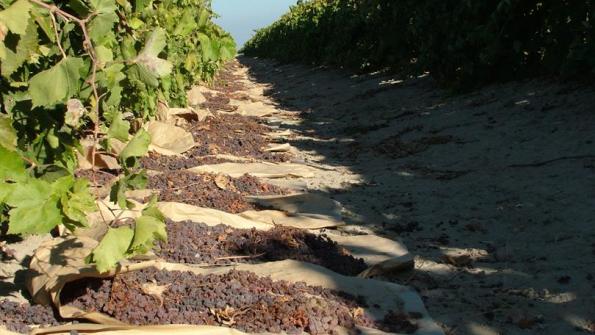
Two weeks or so after California’s raisin growers started placing bunches of Selma Pete and Fiesta grapes on drying trays, most of the Thompson Seedless raisin grape harvest got underway on Labor Day.
This year’s raisin crop appears to be about 30 percent lighter than normal, reports Fresno County raisin grower Jerry Rebensdorf, president of Fresno Cooperative Raisin Growers, Inc., Fresno Calif.
He attributes that to unusually low bunch counts in the spring and unusually hot weather during the summer that continued into the first few days of September.
Heat damage to the crop, which is grown within about a 60-mile radius of Fresno, was widespread. Berries exposed to the sun on top of bunches burned, while others on the lower areas of the vines shriveled.
“Much of the heat damage occurred in July when temperatures reached as high as 110 to 112 degrees,” Rebensdorf says. “On weaker vines, a lot of bunches dried up to nothing. In other cases, where sugar hadn’t yet developed, growers ended up with substandard raisins.”
Other threats to the crop this season, included powdery mildew here and there, rot mites and vine mealybugs, he notes.
Ideally, growers like to remove raisin grapes from the vine with sugar levels of 21 to 22 ºBrix or higher. This year that may have been a challenge for organic growers, who have limited options for controlling mites. Where populations of mites burned the leaves and left them unable to produce sugar, those growers may have ended up picking the grapes at only 18 ºBrix, Rebensdorf says.
Growers producing dry-on-the-vine raisins started severing canes the second week of August for the normal five- to six-week drying period. However, hot weather may have accelerated that process. It could also shorten the usual three weeks or so it normally takes for grapes to dry on trays, particularly for the early- maturing varieties, he adds.
Traditionally, growers haven’t finished picking the raisin grape crop until around Sept. 15th. However, this year, with fewer acres to pick as California’s raisin industry continues to contract plus weather conditions favoring quicker maturity, Rebensdorf expects growers could have most of their raisins dried and out of the fields by the end of September. When they do, they’re likely to be pleased with the results.
“The quality of this year’s raisin grape crop should be very good,” he says.
About the Author(s)
You May Also Like




